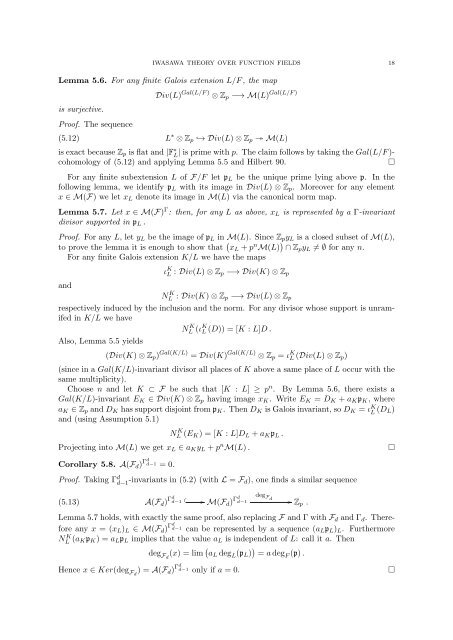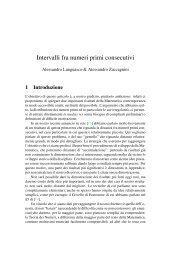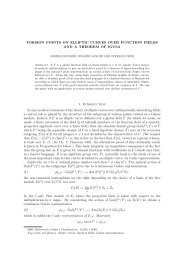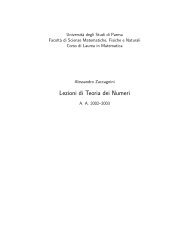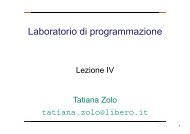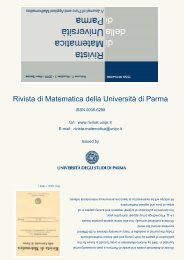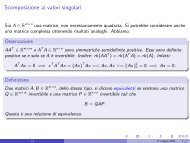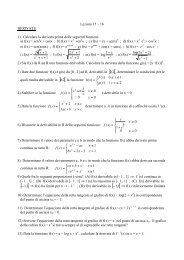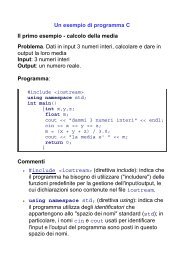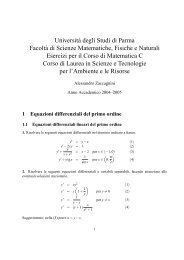<strong>IWASAWA</strong> <strong>THEORY</strong> <strong>OVER</strong> <strong>FUNCTION</strong> <strong>FIELDS</strong> 18Lemma 5.6. For any finite Galois extension L/F , the mapis surjective.Proof. The sequenceDiv(L) Gal(L/F ) ⊗ Z p −→ M(L) Gal(L/F )(5.12) L ∗ ⊗ Z p ↩→ Div(L) ⊗ Z p ↠ M(L)is exact because Z p is flat and |F ∗ L| is prime with p. The claim follows by taking the Gal(L/F )-cohomology of (5.12) and applying Lemma 5.5 and Hilbert 90.□For any finite subextension L of F/F let p L be the unique prime lying above p. In thefollowing lemma, we identify p L with its image in Div(L) ⊗ Z p . Moreover for any elementx ∈ M(F) we let x L denote its image in M(L) via the canonical norm map.Lemma 5.7. Let x ∈ M(F) Γ : then, for any L as above, x L is represented by a Γ-invariantdivisor supported in p L .Proof. For any L, let y L be the image of p L in M(L). Since Z p y L is a closed subset of M(L),to prove the lemma it is enough to show that ( x L + p n M(L) ) ∩ Z p y L ≠ ∅ for any n.For any finite Galois extension K/L we have the mapsι K L : Div(L) ⊗ Z p −→ Div(K) ⊗ Z pandNL K : Div(K) ⊗ Z p −→ Div(L) ⊗ Z prespectively induced by the inclusion and the norm. For any divisor whose support is unramifedin K/L we haveNL K (ι K L (D)) = [K : L]D .Also, Lemma 5.5 yields(Div(K) ⊗ Z p ) Gal(K/L) = Div(K) Gal(K/L) ⊗ Z p = ι K L (Div(L) ⊗ Z p )(since in a Gal(K/L)-invariant divisor all places of K above a same place of L occur with thesame multiplicity).Choose n and let K ⊂ F be such that [K : L] ≥ p n . By Lemma 5.6, there exists aGal(K/L)-invariant E K ∈ Div(K) ⊗ Z p having image x K . Write E K = D K + a K p K , wherea K ∈ Z p and D K has support disjoint from p K . Then D K is Galois invariant, so D K = ι K L (D L)and (using Assumption 5.1)N K L (E K ) = [K : L]D L + a K p L .Projecting into M(L) we get x L ∈ a K y L + p n M(L) .Corollary 5.8. A(F d ) Γd d−1 = 0.Proof. Taking Γ d d−1 -invariants in (5.2) (with L = F d), one finds a similar sequence□(5.13) A(F d ) Γd d−1 M(F d ) Γd d−1deg Fd Z p .Lemma 5.7 holds, with exactly the same proof, also replacing F and Γ with F d and Γ d . Thereforeany x = (x L ) L ∈ M(F d ) Γd d−1 can be represented by a sequence (aL p L ) L . FurthermoreNL K(a Kp K ) = a L p L implies that the value a L is independent of L: call it a. Thendeg Fd(x) = lim ( a L deg L (p L ) ) = a deg F (p) .Hence x ∈ Ker(deg Fd) = A(F d ) Γd d−1 only if a = 0. □
<strong>IWASAWA</strong> <strong>THEORY</strong> <strong>OVER</strong> <strong>FUNCTION</strong> <strong>FIELDS</strong> 19Remark 5.9. The image of the degree map appearing in (5.13) is (deg p)Z p , so deg Fdalwaysprovides an isomorphism between M(F d ) Γd d−1 and Zp . Moreover, if p does not divide deg p,one has surjectivity as well. In this case, looking back at the sequence (5.5), one finds a shortexact sequenceA(F d )/I d d−1 A(F d) M(F d )/I d d−1 M(F d) deg Z p .From (5.1), by taking the limit with L and L ′ varying respectively among subextensions ofF d and F d−1 , one obtains a commutative diagramM(F d )/I d d−1 M(F d)deg Z pNM(F d−1 )deg Fd−1where the map N is the isomorphism induced by the norm, i.e., the one appearing in (5.3).This and the exact sequence (5.2) for L = F d−1 , show that A(F d )/I d d−1 A(F d) ≃ A(F d−1 ) (forany d ≥ 1).From (5.11) one finally obtains(5.14) Ch Λd−1 (A(F d−1 )) = Ch Λd−1 (A(F d )/I d d−1 A(F d)) = π d d−1 (Ch Λ d(A(F d ))) .We remark that this equation holds for any Z p -extension F d /F d−1 satisfying Assumption5.3. If the filtration {F d : d ∈ N} verifies that Assumption at any level d, then the inverseimages of the Ch Λ(Fd )(A(F d )) in Λ (with respect to the canonical projections π Fd : Λ →Λ(F d ) ) form an inverse system and we can defineDefinition 5.10. The pro-characteristic ideal of A(F) is Z p˜Ch Λ (A(F)) := lim←−Fd(π Fd ) −1 (Ch Λ(Fd )(A(F d ))) .Remark 5.11. Two questions naturally arise from the above definition:a. is there a filtration verifying Assumption 5.3 at any level d?b. (assuming a has a positive answer) is the limit independent from the chosen filtration?In the next section we are going to show (in particular in (5.17) and Corollary 5.16) that thereis an element θ ∈ Λ, independent of the filtration and such that, for all F d , its image in Λ(F d )generates Ch Λ(Fd )(A(F d )). Hence Question b has a positive answer (and presumably so doesQuestion a) and we only needed (5.14) as a first step and a natural analogue of (5.16).Nevertheless we believe that these questions have some interest on their own and it would benice to have a direct construction of a “good” filtration {F d : d ∈ N} based on a generalizationof [20, Lemma 2]. Since our goal here is the Main Conjecture we do not pursue this subjectfurther, but we hope to get back to it in a future paper.We also observe that Assumption 5.3 was used only in one passage in the proof of Lemma5.4, as we evidentiated in a footnote. It might be easier to show that in that passage onedoes not need the finitely generated hypothesis: if so, Definition 5.10 would makes sense forall filtrations {F d } d . We are currently considering this approach.Remark 5.12. We could have used Fitting ideals, just as we did in section 3, to provide amore straightforward construction (there would have been no need for preparatory lemmas).But, since the goal is a Main Conjecture, the characteristic ideals, being principal, provide abetter formulation. We indeed expect equality between Fitting and characteristic ideals in allthe cases studied in this paper but, at present, are forced to distinguish between them (butsee Remark 5.17).


